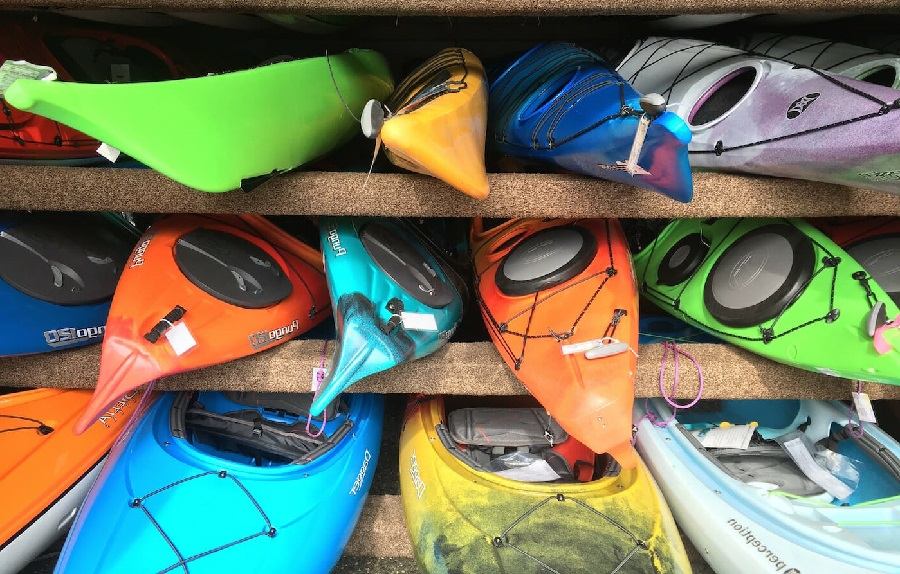Owning a kayak opens up a lot of exciting possibilities. From exploring new areas and overnight camping expeditions to playing on the water with the family on a sunny afternoon.
With the huge variety of kayaks available, choosing one that suits your needs can be tough, but is a lot easier with the right information.
This guide aims to be the most complete and thorough resource available on choosing a kayak and will help guide you through the process.
It covers everything from helping you identify the type of kayak that’s best for you, to looking at various features, and the pros and cons of the different materials kayaks are made out of.
Choosing Your Ideal Kayak
Finding your ideal kayak can be broken down into three steps:
- Clarifying what kind of kayaking you want to do.
- Identifying the type of kayak that fits the type of paddling you want to do.
- Narrowing down the features that are important to you.
Clarifying what kind of kayaking you want to do
Kayaks come in a variety of different shapes and styles. Each type is designed with a different purpose in mind and has its own strengths and weaknesses.
Before deciding on a type of kayak, you first need to consider how you’re going to use it.
Do you want to spend a full day in your kayak, cruising for miles along a rugged stretch of coastline? Or, would you rather go for a leisurely paddle on a lake for a couple of hours on a sunny afternoon?
Here are a few questions to ask yourself to help clarify the kind of kayaking you want to do:
Questions to Ask Yourself
- Water Conditions: What type of water will you be in? Sheltered ponds, lakes, and slow-moving rivers, or exposed coastal waters? How about fast-moving rivers?
- Time on the water: Are you more likely to spend one or two hours on the water or one or two days?
- Distance Travelled: Will you travel longer distances or mostly stick to a certain area?
- Temperature: Will the air and water be warm or cold? Will you be uncomfortable if you get wet?
Now that you’ve got a clearer idea of the type of paddling you want to do, let’s take a look at the different types of kayaks and what kinds of paddling they’re best suited for.
Types of Kayaks
Kayaks are generally categorized by the activity they’re used for, but you’ll also find them categorized by where you sit in them and their structure. Here’s an overview of the different categories — feel free to skip ahead to a specific category.
Quick Note
It’s worth noting that placing a specific kayak into one of these categories isn’t always clear-cut. And different manufacturers don’t always use the same terms to categorize their kayaks.
For example, higher-performance recreational kayaks start to have similar features and are comparable to basic touring kayaks. Likewise, some high-performance touring kayaks start to closely resemble sea kayaks.
Having said that, each category has some defining characteristics that generally hold true.
Sit on top vs Sit in Kayaks
One of the first and easiest ways to start narrowing down your kayak choices is to consider whether you’d rather go for a sit-on-top or a sit-in kayak. Though similar, they both have their own pros and cons.

When picturing a kayak, most people will visualize a sit in kayak. It’s the traditional style people are most familiar with. Over the past several years, though, the sit-on-top variety has become increasingly popular for its ease of use.
Sit on top vs Sit in kayaks
Sit on top
- More stable
- Easier to get on and off of (even in the water)
- Self-bailing and easy capsize recovery
- Heavier
Ideal for: Casual use in warm, sheltered water. Fishing, swimming, and diving. Families.
Not suited for: Cold paddling conditions. Exposed water. Long-distance trips.
Sit in
- Shelters paddlers from cold water and wind
- Faster
- More control while paddling
- Harder capsize recovery
Ideal for: Cooler water. Paddlers who don’t want to get wet. Paddlers who want a faster kayak.
Not suited for: Diving and swimming. Paddlers that find cockpits too restricting.
Sit on top kayaks
Sit-on-top kayaks position the paddler on top of the kayak and are some of the most user-friendly kayaks you’ll find.
Their hulls are usually wider than sit-ins, making them more stable. It’s also easier to get on and off of them because there’s no cockpit to squeeze into. This can make them a good option for paddlers that will use their kayak as a platform for swimming or diving.
Sit-on-top kayaks are self-bailing; you won’t have to pump out water that gets inside the boat. This is achieved through ‘scupper holes’ in the bottom of the boat that allows water to drain out. Recovering from a capsize is also much easier compared to a sit-in kayak.
The major downside to sit-on-tops is that you’re pretty much guaranteed to get wet. You’re not sheltered from splashing water like you are in a sit-in and the scupper holes will let water move freely in and out of the kayak. This makes sit-on-top kayaks less desirable for cold conditions.
Sit in kayaks
Sit-in kayaks have cockpits and keep the paddler sheltered inside the body of the kayak with only their upper body exposed. This protects the paddler from the elements and helps them stay dry. Sit-in kayaks are particularly suited to paddling in cooler water.
Sit-in kayaks can also be used with a spray skirt in rougher conditions, which seals the cockpit and prevents water from getting in. If water does manage to get in, though, you’ll have to pump it out manually. When using a spray skirt, you’ll need to know how to do a ‘wet exit’ in the event of a capsize.
Many sit-ins have sealed hatches that give you a place for storing your essentials and keeping them dry. This makes them better suited for longer trips.
Because they’re not as wide, sit-in kayaks tend to be faster and track straighter through the water than sit-on-top kayaks.
Sit-in kayaks also allow you to brace your knees and feet better, which will give you more power and control while paddling.
Recreational Kayaks
Recreational Kayaks
- Length: 9-12 feet
- Width: 27-36 inches
- Storage space: Minimal
Ideal for: Short trips on calm water. Entry-level paddlers. Paddlers on a budget.
Not suited for Multi-day trips. Waves or rapids.
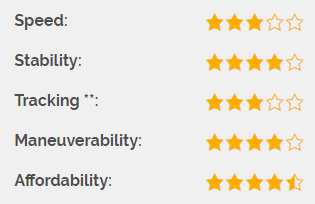
** Tracking: How straight a kayak moves through the water vs swerving side-to-side
Recreational kayaks are arguably the most affordable and popular type of kayak.
The defining characteristic of recreational kayaks is that they are built for stability. They’re also easy to get in and out of and have good maneuverability.
These kayaks are designed for relatively short trips in calm waters like ponds and lakes or sheltered coastal waters. They lack the speed and storage capacity needed for a day or multi-day trips.
It’s best to avoid taking recreational kayaks into exposed ocean waters as they don’t do well in rough or windy conditions.
Recreational kayaks come in both sit-on-top and traditional sit-in styles, as well as both inflatable and rigid bodies. Higher-end sit-in recreational kayaks can perform similarly to low-end touring kayaks.
Touring Kayaks
Touring Kayaks
- Length: 12-16 feet
- Width: 23-27 inches
- Storage space: Moderate to ample
- Good balance of performance and stability
Ideal for: Full-day or multi-day trips. Kayak camping. Long distances. Moderately rough water.
Not suited for: It May be overkill for casual paddlers.
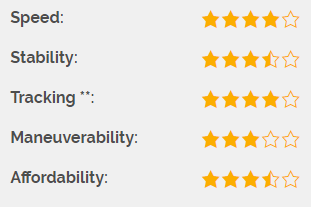
** Tracking: How straight a kayak moves through the water vs swerving side-to-side
These boats offer a good compromise between performance, stability, and comfort. They’re faster and move more efficiently through the water than recreational kayaks. Many have either a rudder or skeg to help them track straight. You’ll only find them in the traditional sit in style.
Touring kayaks are designed to be used for longer day trips or overnight camping excursions and do a decent job cutting through rough water. They’re sometimes further categorized into day touring and multi-day touring varieties.
Multi-day touring kayaks are faster, have more storage space, and handle adverse conditions better than the day-touring variety. They’re great over long distances. Higher-end multi-day touring kayaks perform similarly to sea kayaks and typically fall on the pricier end of the spectrum.
Day touring kayaks don’t have quite as much storage space and aren’t quite as capable as multi-day touring kayaks in rough water. They’re shorter than the multi-day variety, which means they’re lighter and easier to transport. They’re also easier on your wallet.
Sea Kayaks
Sea Kayaks
- Length: Longer than 16 feet
- Width: 23 inches or less
- Storage space: Ample
- Very fast and efficient
Ideal for: Excels in rough open water. Long distance and multi-day excursions.
Not suited for: Narrow, winding rivers. Overkill for small ponds and lakes.
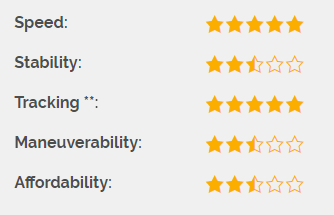
** Tracking: How straight a kayak moves through the water vs swerving side-to-side
Sea kayaks are on the opposite side of the spectrum from recreational kayaks. They’re built to cut through the water as efficiently as possible and to weather the unpredictable conditions of open water paddling.
With their long, narrow hulls, sea kayaks are as fast and efficient as they come. Their hulls typically have a strong “V” shape and either a skeg or a rudder, which helps them to track straight in the water, despite rough conditions.
Sea kayaks have one or two bulkheads that serve the important function of providing flotation in case the cockpit becomes swamped with water. They also double as a dry storage area for your gear.
To handle rough conditions, sea kayaks have small cockpits which help keep water out along with the use of a spray skirt. Paddlers that are not accustomed to the smaller cockpit size may find it somewhat restrictive.
One major drawback of the narrow hull design is that sea kayaks can capsize fairly easily compared to other types of kayaks. If you do plan to hit the water in one, it’s a good idea to take a sea kayaking course so you’re prepared to deal with a capsize in rough water.
Inflatable Kayaks
Inflatable Kayaks
- Length: 10-15 feet
- Width: 32-40 inches
- Storage space: Minimal to moderate
- Ultra-portable and easy to store when not in use
- Higher-quality inflatables can be surprisingly durable
Ideal for: Paddlers low on storage space. Keeping your kayak in your car for spontaneous paddle sessions. Hiking into remote paddling locations. Families.
Not suited for: Rough or exposed open water conditions.
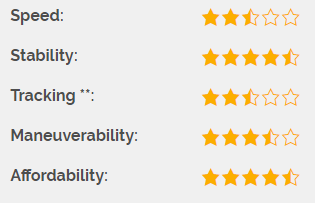
** Tracking: How straight a kayak moves through the water vs swerving side-to-side
f you have limited storage space or want a kayak that’s easy to transport, an inflatable kayak could be a good choice. Most pack away into a large duffle bag.
There is a surprisingly wide variety of inflatable kayaks. Entry-level inflatables can be found for about $100, while higher-end models are priced similarly to hard-shell kayaks.
Inflatable kayaks run on the wide side of the spectrum, which makes them very stable and the best inflatable kayaks can be surprisingly durable. And if you do manage to puncture them, they can often be repaired without much trouble.
One drawback with inflatable kayaks is they take additional time to inflate and deflate. You also need to make sure it’s dry before you pack it up and store it away, which can be a bit of an inconvenience.
Inflatable kayaks tend to be fairly affordable making them a solid choice if you’re on a budget or only plan on using them a handful of times during the summer then tucking them away for the rest of the year.
Fishing Kayaks
Fishing Kayaks
- Length: 9-14 feet
- Width: 30-36 inches
- Storage space: Varies
- Specialized features for anglers
Ideal for: Dedicated anglers and casual paddlers that occasionally like to fish.
Not suited for: Long distance trips or rough conditions.

** Tracking: How straight a kayak moves through the water vs swerving side-to-side
Fishing kayaks have additional features to make life easier for anglers. They come in a huge variety of styles from both sit-in and sit-on-top to hard-bodied and inflatable alike. Likewise, the way individual fishing kayaks perform can vary greatly.
Generally, anglers prefer the sit-on-top variety for quick access to gear and freedom of movement. Though, anglers who fish in cold or rough conditions may prefer a sit-in model. In either case, fishing kayaks tend to have wider hulls for increased stability while bringing in fish.
Some of the common features include rod holders, storage space for coolers and tackle, and mounting points for fish finders and motors. Some models have specialized pedal drive systems that allow the angler to propel the kayak without a paddle, keeping their hands free to hold a rod.
Fishing kayaks fall within a wide range of prices. Basic models are affordable and are similarly priced to recreational kayaks. More specialized pedal-drive fishing kayaks can easily be as expensive as a nice touring kayak.
Whitewater Kayaks
Whitewater kayaks
- Length: 5-10 feet
- Width: 24-28 inches
- Storage space: Minimal
Ideal for: Fast-moving water. Ocean surf.
Not suited for: Long-distance trips.
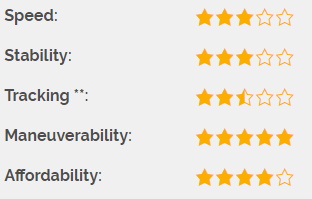
** Tracking: How straight a kayak moves through the water vs swerving side-to-side
Whitewater kayaks are meant for paddling through rapids or in the surf and are a bit of a special breed of a kayak.
They’re short and stubby and primarily designed to be very maneuverable, which comes in handy when you’re dodging obstacles on a fast-moving river. Speed isn’t a big concern as you’re primarily propelled by the water.
Within the overarching white water category, there are few more specialized subcategories.
- Creek boats
- Play boats
- Downriver boats
The design of the specialized boats emphasizes different styles of whitewater paddling. Creek boats focus on buoyancy and maneuverability, while play boats have less buoyancy that allows for playing in the water and performing freestyle tricks. Downriver boats are a hybrid of the two.
Kayak Sizing and Why it Matters
A kayak’s size primarily relates to its length and width (beam) but also includes its depth. Each type of kayak generally falls within a size range, but there can still be a significant difference even between boats in the same category.
| Recreational | Sea Kayak | Touring | Inflatable | Fishing | Whitewater | |
| Length | 9-12 feet | 16-19 feet | 12-15 feet | 8-13 feet | 8-13 feet | 5-8 feet |
| Width | 27-36 in. | < 23 in. | 23-27 in. | 32-40 in. | 30-36 in. | 24-28 in. |
The size of a kayak plays a major role in the…
- Performance
- Weight capacity
- Storage capacity
- Ease of transportation & storage
- Comfort
- Price
…of a kayak. It’s worthwhile understanding what effect the length and width of a kayak have so you can pick a kayak that’s better tailored to your needs.
Quick Note – Kayak design trade-offs
Kayak design is a game of trade-offs, you won’t find one type of kayak that excels at everything.
Speed vs Stability
One of the major trade-offs you’ll find is between speed and stability. As a rule of thumb, kayaks will fall along a spectrum. They’re either very fast/unstable, slow/very stable, or fall somewhere in the middle.
If you want more speed, you’ll usually have to sacrifice some stability and vice versa.
Maneuverability vs Tracking
The other major trade-off you’ll find is between a kayak’s maneuverability and its ability to track (go straight) through the water — instead of swerving from side to side as you paddle.
If you plan to cover longer distances, look for a kayak that tracks well. Having your kayak zigzag through the water becomes very inefficient over longer distances.
Performance
Length – A longer kayak generally cuts through the water more efficiently, which translates to better speed and tracking in the water. Shorter kayaks have the advantage of being more maneuverable.
Width – Wider kayaks will have more initial stability. Narrower ones allow the boat to glide through the water better, requiring less effort to go at the same speed.
Depth – If a kayak is too deep it makes it difficult to paddle efficiently.
Weight capacity
A larger kayak – in length, width, and depth – will generally have a higher weight capacity than a smaller one. Most manufacturers will label the weight capacity of their kayaks, so you usually don’t have to guess.
Storage capacity
Larger kayaks have more physical space to store your gear. Their higher weight capacity also means you’ll be able to carry heavier gear.
Ease of transportation & storage
Somewhat obvious, but still worth noting is that a smaller kayak is going to be a lot easier to transport and store. They’re also lighter, which can make them easier to lift onto roof racks or carry to your launching point.
Comfort
If you’re concerned about squeezing into a narrow cockpit, look for a wider kayak as they tend to have more open cockpits.
On a similar note, a wider kayak will give you more room to move your legs inside the boat. Some are wide enough that you can even cross your legs.
If you’re on the tall side, keep an eye out for deeper kayaks; they’ll give you a bit more leg room.
Price
Smaller kayaks are cheaper because they simply require less material to make. If you don’t need the benefits of a larger kayak, you’re better off saving some money and getting a smaller one.
Specific Features & Considerations
Weight Capacity
Most kayak manufacturers will label the weight capacity of their kayaks. Just keep in mind that the weight listed is typically its maximum capacity; If you’re 250 pounds, and your kayak has a weight capacity of 250 pounds, it’ll be sitting very low in the water and perform poorly. And that’s not even considering the weight of your gear.
As a rule of thumb, shoot for a weight capacity of about 50% more than the expected weight of you plus your gear.
For example, say you’re 175 pounds and your gear is 25 pounds for a total of 200 pounds. You’d want to look for a kayak with a weight capacity that’s 50% more than 200; or a weight capacity in the ballpark of 300 pounds.
Rudders & Skegs
Some kayaks come with a built in or optional skeg or rudder. Skegs will help improve your tracking through the water, while rudders can help improve both tracking and maneuverability.
Seats
Having a quality seat is arguably one of the biggest things you can do to improve your comfort level and ensure you enjoy your time on the water.
If you’re only spending a few hours on the water at a time, you may be able to get away with a lower-quality seat. But if you plan on being out for half a day or more, make sure your kayak comes with a comfortable seat or buy a good one separately.
Cockpit Size
Larger cockpits tend to be more comfortable and make it easier to get in and out of the boat. It also means that it’s easier for water to get inside the kayak if you’re not using a spray skirt.
Smaller cockpits will offer you more protection in rough conditions as well as give you more control by allowing you to brace your knees against it.
Storage Hatches & Deck Rigging
If you’ll be using your kayak for extended trips or camping, try to get an idea of how much space you’ll need for gear.
Touring and sea kayaks often come with one or two storage hatches. On calm days, you can also use deck rigging for additional storage.
Carry Handles
If you anticipate having to carry your kayak very far or move it when it’s loaded down with gear, keep an eye out for built-in carry handles. They make a surprising difference even over short distances.
Tandem vs Single Kayaks
Every type of kayak we covered can be found in both single and tandem setups.
Tandems can be a good option if you know that you’ll only ever go out with your paddle partner – and tandems are almost always cheaper than two single kayaks.
You’re typically more engaged in conversation in a tandem kayak, and it’ll be more of a shared experience (for better or worse). If your paddling is in sync and you both want to go in the same direction tandems are a lot of fun. If you’re out of sync… well, it can be a little frustrating.
Having two single kayaks gives you the most freedom and it’s always good to have a second boat around if one of them capsizes. The downside is that it’s more expensive and not as much of a shared experience.
A third option is to find a tandem to solo conversion kayak. These kayaks have a jump seat in between the two main seats that also allow you to paddle solo. It’s definitely not as comfortable or as efficient as a solo kayak but it’s an option worth looking into.
Materials
The materials a kayak is constructed out of impact its:
- Performance – Smoother materials reduce drag and allow kayaks to move faster.
- Weight – Heavier materials make kayaks harder to lift up and transport.
- Durability – Kayaks need to survive bumping into rocks and other obstacles.
- Price – Certain materials and processes are more expensive or have higher labor costs.
Here’s a quick overview of the most common materials and how they compare.
Polyethylene Plastic
Polyethylene Plastic
- Low Maintenance
- Abrasion can rough up the hull and reduce speed over time
- Susceptible to UV damage – Should be stored out of direct sunlight
Ideal for: Casual paddlers that don’t want to worry about pampering their kayak. Paddling near rocky areas. Paddlers on a budget.
Polyethylene is the most common material used in kayak construction. Polyethylene kayaks are formed in a process called ‘rotomolding’, in which plastic pellets are poured into a hollow mold of the kayak. The mold is then heated and rotated until the plastic melts and coats the inside of the mold.
After it’s cool and removed from the mold, you’re left with a kayak made out of a single piece of plastic.
ABS Plastic (Thermoform)
ABS Plastic (Thermoform)
- UV Resistant
- Good balance between performance and price.
Ideal for: Paddlers that want a high-performance kayak without spending twice as much for a composite hull.
Thermoformed hulls are made by placing a sheet of ABS plastic over a mold. The plastic sheet is then heated and, using vacuum suction, is formed to the shape of the mold.
Thermoformed kayaks offer a good compromise between the affordability and durability of polyethylene kayaks, while also being comparable to composites in terms of weight.
Composites
Composites
- Very rigid and responsive
- Susceptible to direct hits from rocks or drops
- Fairly easy to repair if damaged
Ideal for: Paddlers that want to get the most performance out of their kayak and don’t mind paying top dollar for it.
Composite kayaks are made by layering tough fabrics (like fiberglass, carbon fiber, and kevlar) in a mold and using a gelcoat to give it strength and rigidity.
Besides being lightweight, composite materials make for a very rigid kayak, which translates to speed. Composite kayaks are as fast as they come. They’re also near the top of the list in terms of price.
Wood
Wood
- Aesthetically beautiful
- Can be DIY built using a kit but takes time and some skill
Ideal for: Paddlers that want to turn heads while they paddle or want the satisfaction of building a kayak with their own two hands.
Kayaks made out of wood are primarily from “Do It Yourself” builders, but you can find them for sale if you look hard enough. Once built, a fiberglass and varnish coating is typically applied on the outside of the wooden hull for greater strength and to protect the wood.
Where wooden kayaks really shine is in the aesthetics department. Few kayaks have the ability to turn heads like a beautiful wooden kayak gliding through the water.
Besides being easy on the eyes, wooden kayaks actually perform quite well. One drawback is that you won’t find many features with wooden kayaks, they tend to be pretty minimalistic.
Inflatable
Inflatable kayaks are commonly made with two types of materials. The first are synthetic rubbers, which include Hypalon, NRS Pennel Orca, and neoprene. The second are plastic polymers like PVC and polyurethane.
Both are constructed utilizing a core layer of tough fabric and coating it with either rubber or plastic. The material is then either glued or welded together to form an air-tight seal, which can then be inflated.
It’s worth noting that some inflatable kayaks have rigid frames, which significantly improve their performance.
Both have their pros and cons, so we’ll look at them separately.
Synthetic Rubbers
Synthetic Rubbers
- Durable but hard to repair
- Heavier than PVC
- Packs down tighter than PVC
- Resistant to UV and solvents
Plastic Polymers
Plastic Polymers
- Can be made very light at the expense of durability
- Very affordable
- UV damage susceptible
- PVC manufacturing process may damage the environment
Hull Shape
The shape of a kayak’s hull (bottom of the kayak) isn’t the first thing you need to think about when you first start shopping for a kayak. But, when you’ve narrowed your choice down to a few kayaks, comparing their hull shapes can give you a better idea of how one is likely to perform compared to another.

V-Shaped – These hulls have a noticeably sharper “V” shape. This helps them track straight and cut through the water. The downside is they tend to be less stable.
Rounded – Rounded hulls have a smoother curve, which helps reduce water resistance and improves speed. Like the “V” shaped hull, these aren’t as stable as some of the other hull shapes.
Flat – Stability and maneuverability are the name of the game with flat-bottomed hulls. Just don’t plan on moving very fast.
Pontoon – Pontoon hulls offer the best all-around stability, but are the slowest of the four.
Many kayak hulls actually use a combination of different hull shapes.
For example, having a V-shape near the front of the boat helps cut through the water and gradually move to a flatter or rounder shape underneath the cockpit for improved stability.

